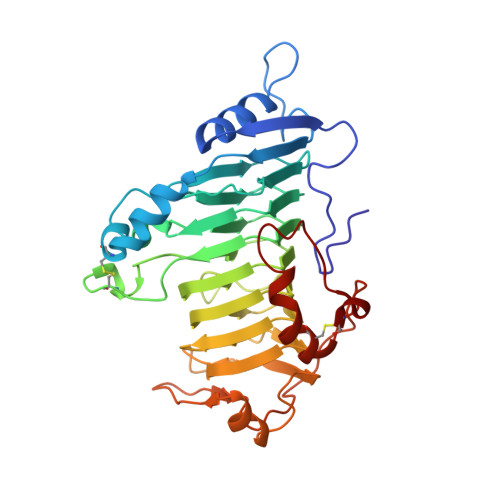Structure of a Plant Cell Wall Fragment Complexed to Pectate Lyase C
Scavetta, R.D., Herron, S.R., Hotchkiss, A.T., Kita, N., Keen, N.T., Benen, J.A., Kester, H.C., Visser, J., Jurnak, F.(1999) Plant Cell 11: 1081-1092
- PubMed: 10368179
- DOI: https://doi.org/10.1105/tpc.11.6.1081
- Primary Citation of Related Structures:
2EWE - PubMed Abstract:
The three-dimensional structure of a complex between the pectate lyase C (PelC) R218K mutant and a plant cell wall fragment has been determined by x-ray diffraction techniques to a resolution of 2.2 A and refined to a crystallographic R factor of 18.6%. The oligosaccharide substrate, alpha-D-GalpA-([1-->4]-alpha-D-GalpA)3-(1-->4)-D-GalpA , is composed of five galacturonopyranose units (D-GalpA) linked by alpha-(1-->4) glycosidic bonds. PelC is secreted by the plant pathogen Erwinia chrysanthemi and degrades the pectate component of plant cell walls in soft rot diseases. The substrate has been trapped in crystals by using the inactive R218K mutant. Four of the five saccharide units of the substrate are well ordered and represent an atomic view of the pectate component in plant cell walls. The conformation of the pectate fragment is a mix of 21 and 31 right-handed helices. The substrate binds in a cleft, interacting primarily with positively charged groups: either lysine or arginine amino acids on PelC or the four Ca2+ ions found in the complex. The observed protein-oligosaccharide interactions provide a functional explanation for many of the invariant and conserved amino acids in the pectate lyase family of proteins. Because the R218K PelC-galacturonopentaose complex represents an intermediate in the reaction pathway, the structure also reveals important details regarding the enzymatic mechanism. Notably, the results suggest that an arginine, which is invariant in the pectate lyase superfamily, is the amino acid that initiates proton abstraction during the beta elimination cleavage of polygalacturonic acid.
Organizational Affiliation:
Department of Physiology and Biophysics, 346-D Med Sci I, University of California, Irvine, California 92697-4560, USA.
















